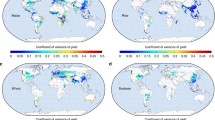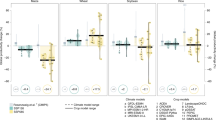Abstract
Climate change has the potential to be a source of increased variability if crops are more frequently exposed to damaging weather conditions. Yield variability could respond to a shift in the frequency of extreme events to which crops are susceptible, or if weather becomes more variable. Here we focus on the United States, which produces about 40% of the world’s maize, much of it in areas that are expected to see increased interannual variability in temperature. We combine a statistical crop model based on historical climate and yield data for 1950–2005 with temperature and precipitation projections from 15 different global circulation models. Holding current growing area constant, aggregate yields are projected to decrease by an average of 18% by 2030–2050 relative to 1980–2000 while the coefficient of variation of yield increases by an average of 47%. Projections from 13 out of 15 climate models result in an aggregate increase in national yield coefficient of variation, indicating that maize yields are likely to become more volatile in this key growing region without effective adaptation responses. Rising CO2 could partially dampen this increase in variability through improved water use efficiency in dry years, but we expect any interactions between CO2 and temperature or precipitation to have little effect on mean yield changes.



Similar content being viewed by others
References
Diffenbaugh NS, Ashfaq M (2010) Intensification of hot extremes in the United States. Geophys Res Lett 37:5. doi:201010.1029/2010GL043888
Easterling DR, Meehl GA, Parmesan C, Changnon SA, Karl TR, Mearns LO (2000) Climate extremes: observations, modeling, and impacts. Science 289:2068–2074. doi:10.1126/science.289.5487.2068
Grassini P, Yang H, Cassman KG (2009) Limits to maize productivity in Western Corn-Belt: a simulation analysis for fully irrigated and rainfed conditions. Agric For Meteorol 149:1254–1265. doi:10.1016/j.agrformet.2009.02.012
Hawkins E, Sutton R (2010) The potential to narrow uncertainty in projections of regional precipitation change. Clim Dyn 37:407–418. doi:10.1007/s00382-010-0810-6
Jewson S, Hawkins E (2009) CMIP3 ensemble spread, model similarity, and climate prediction uncertainty. arXiv:09091890. http://arxiv.org/abs/0909.1890
Knutti R (2010) The end of model democracy? Clim Chang 102:395–404. doi:10.1007/s10584-010-9800-2
Leakey ADB, Ainsworth EA, Bernacchi CJ, Rogers A, Long SP, Ort DR (2009) Elevated CO2 effects on plant carbon, nitrogen, and water relations: six important lessons from FACE. J Exp Bot 60:2859–2876. doi:10.1093/jxb/erp096
Lobell DB, Burke MB (2010) On the use of statistical models to predict crop yield responses to climate change. Agric For Meteorol 150:1443–1452. doi:10.1016/j.agrformet.2010.07.008
Markelz RJC, Strellner RS, Leakey ADB (2011) Impairment of C4 photosynthesis by drought is exacerbated by limiting nitrogen and ameliorated by elevated [CO2] in maize. J Exp Bot 62:3235–3246. doi:10.1093/jxb/err056
Maurer EP, Brekke L, Pruitt T, Duffy PB (2007) Fine-resolution climate projections enhance regional climate change impact studies. Eos Trans AGU 88:504. doi:200710.1029/2007EO470006
McGrath JM, Lobell DB (2011) An independent method of deriving the carbon dioxide fertilization effect in dry conditions using historical yield data from wet and dry years. Glob Chang Biol 17:2689–2696. doi:10.1111/j.1365-2486.2011.02406.x
Mearns LO, Rosenzweig C, Goldberg R (1996) The effect of changes in daily and interannual climatic variability on CERES-Wheat: a sensitivity study. Clim Chang 32:257–292. doi:10.1007/BF00142465
Mearns LO, Rosenzweig C, Goldberg R (1997) Mean and variance change in climate scenarios: methods, agricultural applications, and measures of uncertainty. Clim Chang 35:367–396
Olesen JE, Carter TR, Díaz-Ambrona CH, Fronzek S, Heidmann T, Hickler T, Holt T, Minguez MI, Morales P, Palutikof JP, Quemada M, Ruiz-Ramos M, Rubæk GH, Sau F, Smith B, Sykes MT (2007) Uncertainties in projected impacts of climate change on European agriculture and terrestrial ecosystems based on scenarios from regional climate models. Clim Chang 81:123–143. doi:10.1007/s10584-006-9216-1
Parry M, Rosenzweig C, Iglesias A, Livermore M, Fischer G (2004) Effects of climate change on global food production under SRES emissions and socio-economic scenarios. Glob Environ Chang 14:53–67. doi:10.1016/j.gloenvcha.2003.10.008
Räisänen J (2002) CO2-induced changes in interannual temperature and precipitation variability in 19 CMIP2 experiments. J Clim 15:2395–2411. doi:10.1175/1520-0442(2002) 015<2395:CICIIT>2.0.CO;2
Reilly J, Tubiello F, McCarl B, Abler D, Darwin R, Fuglie K, Hollinger S, Izaurralde C, Jagtap S, Jones J, Mearns L, Ojima D, Paul E, Paustian K, Riha S, Rosenberg N, Rosenzweig C (2003) U.S. agriculture and climate change: new results. Clim Chang 57:43–67. doi:10.1023/A:1022103315424
Rosenzweig C, Tubiello FN, Goldberg R, Mills E, Bloomfield J (2002) Increased crop damage in the US from excess precipitation under climate change. Glob Environ Chang 12:197–202. doi:10.1016/S0959-3780(02)00008-0
Schlenker W, Roberts MJ (2009) Nonlinear temperature effects indicate severe damages to U.S. crop yields under climate change. Proc Natl Acad Sci 106:15594–15598. doi:10.1073/pnas.0906865106
Schlenker W, Hanemann WM, Fisher AC (2005) Will U.S. agriculture really benefit from global warming? accounting for irrigation in the hedonic approach. Am Econ Rev 95:395–406
Southworth J, Randolph JC, Habeck M, Doering OC, Pfeifer RA, Rao DG, Johnston JJ (2000) Consequences of future climate change and changing climate variability on maize yields in the Midwestern United States. Agric Ecosyst Environ 82:139–158. doi:16/S0167-8809(00)00223-1
Thomson A, Brown R, Rosenberg N, Srinivasan R, Izaurralde R (2005) Climate change impacts for the conterminous USA: an integrated assessment. In: Rosenberg N, Edmonds J (eds) Climate Change Impacts for the Conterminous USA. Springer Netherlands, pp 67–88. http://dx.doi.org/10.1007/1-4020-3876-3_5
Wetherald RT, Manabe S (1995) The mechanisms of summer dryness induced by greenhouse warming. J Clim 8:3096–3108. doi:10.1175/1520-0442(1995) 008<3096:TMOSDI>2.0.CO;2
Acknowledgements
We thank three reviewers for helpful comments. This work was supported by supported by NSF grant SES-0962625 and a Stanford Graduate Fellowship.
Author information
Authors and Affiliations
Corresponding author
Electronic supplementary material
Below is the link to the electronic supplementary material.
Table S1
Quantiles of temperature in the training data and future period as projected by 15 GCMs. (DOC 26 kb)
Figure S1
Aggregate yield at each year in the 1950–2005 training period. Detrending both the observed and fitted aggregate yields by regressing on year + year2 gives an R2 between the aggregate yield trends of 0.39, meaning we are explaining roughly 40% of the variance in aggregate yield residuals with weather effects. The large drop in observed yields in 1993 that our model misses was a result of heavy flooding. (PDF 22 kb)
Figure S2
(a) The percent changes in the coefficient of variation of predicted yields in 2030–2050 relative to 1980–2000 as a function of mean growing season temperature in the base period. Each point in the scatter corresponds to an individual county. Cooler counties exhibit bigger increases as they move away from the optimum growing season T. (b) The same quantity as (a) but for the total yield variance, which includes the variance of predicted yields as well as the variance of the model residuals, with the latter assumed to remain constant in future climate. (c) The fraction of observed variance explained by the model in each county, plotted against the mean T in that county. Because the model explains much less variance of the time-detrended yields in cooler than in warmer counties, the residual variance contributes a greater relative share to the total variance. Thus, although the variance of predicted yields goes up more in cooler counties, the total variance is projected to go up more in the warmer counties. (PDF 43 kb)
Figure S3
Scatterplot of the square of residuals from the training data fit as a function of temperature, overlaid with a local linear nonparametric fit. The fit shows a slight increasing trend in residuals at higher temperatures, but the trend is weak, with a correlation between the fitted values and data points of 0.0036. (PDF 34 kb)
Figure S4
A quantile regression of yield anomalies on the same set of predictors as the ordinary least squares (OLS) regression shows little distinction in the shape of the distributions of quantile yields as a function of temperature. The higher quantiles show slightly less dropoff at higher temperatures, but combined with the small amount of variance in the residuals explained by temperature, it seems the effect of trends in unexplained variance is small. (PDF 18 kb)
Figure S5
The distribution of log-fitted yields of the panel data more nearly matches the distribution of actual panel yields than does the linear fit, adding support to our choice to regress log of yields rather than actual yields on the weather and county predictors. (PDF 75 kb)
Rights and permissions
About this article
Cite this article
Urban, D., Roberts, M.J., Schlenker, W. et al. Projected temperature changes indicate significant increase in interannual variability of U.S. maize yields. Climatic Change 112, 525–533 (2012). https://doi.org/10.1007/s10584-012-0428-2
Received:
Accepted:
Published:
Issue Date:
DOI: https://doi.org/10.1007/s10584-012-0428-2




